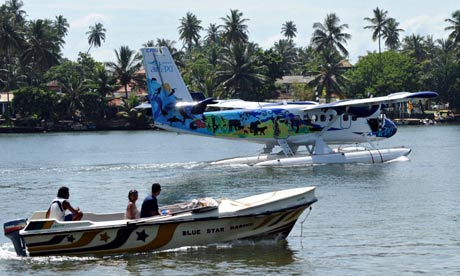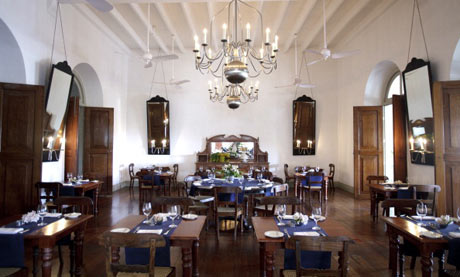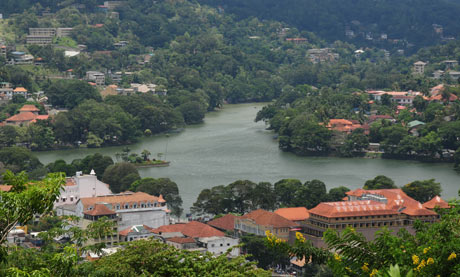A
thrilling new seaplane service in Sri Lanka takes you from Colombo into
the hill country, landing on temple lakes – and the tickets start at
just £30


One of SriLankan Air
Taxis' seaplanes. Photograph: Ishara S Kodikara/AFP/Getty Images. Click
on the magnifying glass icon to see a map of the places visited
It was at Koggala lake, near Galle, that I first saw the seaplane that was to whisk me up to Sri Lanka's
lush and temperate tea country. There, bobbing up and down, lashed to a
floating dock, was the white dual-engine DeHavilland Twin Otter, on its
tail a phantasmagoric mural depicting the supposed sights of Sri Lanka:
leopards, giant squid, elephants and whales.
Seeing the plane floating on two giant pontoons, its wings set on top of a fuselage that holds 15 passengers, I was transported back to a time when air travel was still an adventure, when stepping onto a plane amid the uproar of whizzing propellers felt intrepid.
I'd long wanted to visit Sri Lanka's hills, though driving from Colombo up to Kandy and then on to Nuwara Eliya – while an exciting experience – can eat away at your itinerary. That's why, on a recent trip, I decided to see the country from the sky, by opting to take SriLankan Air Taxi, a little-known seaplane service that, for the price of a hire car, plies routes from Colombo to the coastal towns of Galle and Tangalle, as well as the hill towns of Kandy and Nuwara Eliya, and Dambulla, famous for its cave temple complex.
SriLankan Airlines' seaplane service was set up in 2004 but was promptly suspended due to the country's protracted civil war, which finally ended in 2009. The service was re-launched last year but its existence is still under the radar. It has only been possible to book online since June 2012.
The ceasefire has been a boon to domestic air travel. It is now possible to fly from Colombo to Jaffna in a Cessna operated by ExpoAir (expoavi.com) and another seaplane service, Cinnamon Air (cinnamonair.com), will be launched in early 2013.
Over a piquant fish curry on the veranda of the painstakingly restored Amangalla hotel in the Dutch fort at Galle, I imagined life in wartime Ceylon, having read about Sri Lanka's seaplane legacy and Leonard Birchall, the Canadian second world war pilot remembered as the "saviour of Ceylon". After taking off from Koggala lake, about nine miles east of Galle in a Catalina "flying boat" seaplane in 1942, Birchall spotted a "black speck" on the horizon, which turned out to be the Japanese fleet, the co-ordinates of which he radioed back to Colombo before being shot down (he survived).
 The hotel dining room at Amangalla hotel. Photograph: ./Bloomberg
Today, Koggala is still a naval base, and doubles as a SriLankan Air
Taxi runway. I took the morning flight to Colombo for £40. The cabin was
basic and unpressurised; the seatbelt was the only amenity. There was
no cockpit door, so I was able to watch the captain and copilot
manipulate the yoke, foot pedals and throttles. I could read the plane's
instruments and feel the vibration of the propellers.
The hotel dining room at Amangalla hotel. Photograph: ./Bloomberg
Today, Koggala is still a naval base, and doubles as a SriLankan Air
Taxi runway. I took the morning flight to Colombo for £40. The cabin was
basic and unpressurised; the seatbelt was the only amenity. There was
no cockpit door, so I was able to watch the captain and copilot
manipulate the yoke, foot pedals and throttles. I could read the plane's
instruments and feel the vibration of the propellers.
The plane only needed about a quarter of a mile to take off. Rising off the water, we climbed steeply to 7,500ft and for most of the 45-minute journey followed the ribbon of the Colombo-Galle highway as it bisected paddy fields and palm oil plantations. I barely moved my eyes from the window, from which I could see hilltop Buddhist temples, mosques and cricket pitches.
As we approached Colombo, the pilot banked the plane to the left and we followed the coast to one of SriLankan's two bases in the capital. Since landing a seaplane depends on water levels, currents and visibility, the air taxi's schedules are flexible, their bases changeable. Two more bases are being prepared, one downtown at Colombo Fort and another at the international airport.
During the layover the pilot, Canadian George McBain, told me that, though run by SriLankan Airlines, the whole operation – the plane, the crews, the maintenance – have been leased from Kenn Borek Air, a Canada-based charter airline specialising in Twin Otters. Borek Air leases SriLankan the same planes that ply hunting and fishing lodges in western Canada and Alaska, and support Antarctic research missions. "The Twin Otter is fun to fly," McBain said. "It can go anywhere. There is no other plane in the world that can fly where it goes. It can fly in the open oceans in the Maldives, land on riverbeds, frozen water, glaciers. And you can't see anything from a jet. At 5,000 or 10,000 feet, I have stuff to look at all day long."
 Fly into the heart of Kandy. Photograph: Getty Images
We flew to Kandy from the Peliyagoda base, which is at an elbow in
the river Kelani in a suburb of Colombo. Its dock is leased from a
Buddhist temple, its terminal comprised of a collection red plastic
chairs. I spun the giant prayer wheels under the gaze of a statue of a
standing Buddha as five passengers checked in, posed for pictures on the
dock and inspected the plane.
Fly into the heart of Kandy. Photograph: Getty Images
We flew to Kandy from the Peliyagoda base, which is at an elbow in
the river Kelani in a suburb of Colombo. Its dock is leased from a
Buddhist temple, its terminal comprised of a collection red plastic
chairs. I spun the giant prayer wheels under the gaze of a statue of a
standing Buddha as five passengers checked in, posed for pictures on the
dock and inspected the plane.
As we flew north-east from Colombo towards the hills, we passed in and out of clouds, the plane skating gently on the wind. Passengers took photographs of waterfalls, plantation houses, still more temples and cricket pitches.
At Kandy, we descended between the trees lining a dammed segment of the Mohaweli river. There were about 50 locals by the dock waiting for the plane to land, taking pictures on their mobile phones. After disembarking, Saleh al-Estry, an Omani tourist who was on my flight, called the journey "fantastic". He said he clicked the seaplane icon on the SriLankan website by chance. "I saw there was a seaplane and thought, 'I should try this'," he said. "The funny thing is, in Colombo nobody knows about this. Even the guy in my hotel had never heard of it."
After a walk around Kandy lake and a tour of the Temple of the Sacred Tooth Relic, which supposedly houses one of the Buddha's teeth, I boarded a train for the former British redoubt of Nuwara Eliya, Sri Lanka's best-known hill station. For three hours we wound through the jungle and tea plantations I'd seen from the air and at station stops I bought sweet coconuts and wadi (fried savory snacks with chilli chutney) through the window.
After a night at the Hill Club, a rambling colonial pile where guests are served seafood thermidor in a formal dining room by white-gloved waiters, I embarked on the flight from lake Gregory back to Colombo. Seaplane travel now felt routine. In the air I thought of all the remote places I've been that could be made less remote by Twin Otters, and thought with vertiginous dread of the inevitability of future long-distance journeys on pitted and perilous roads.
Not in Sri Lanka, though. George McBain, the pilot, suspected he'd see me again. "A lot of passengers – the ones that we do have – are repeat passengers," he said.
http://www.guardian.co.uk/travel/2013/jan/26/sri-lanka-seaplane-service-kandy-galle
Seeing the plane floating on two giant pontoons, its wings set on top of a fuselage that holds 15 passengers, I was transported back to a time when air travel was still an adventure, when stepping onto a plane amid the uproar of whizzing propellers felt intrepid.
I'd long wanted to visit Sri Lanka's hills, though driving from Colombo up to Kandy and then on to Nuwara Eliya – while an exciting experience – can eat away at your itinerary. That's why, on a recent trip, I decided to see the country from the sky, by opting to take SriLankan Air Taxi, a little-known seaplane service that, for the price of a hire car, plies routes from Colombo to the coastal towns of Galle and Tangalle, as well as the hill towns of Kandy and Nuwara Eliya, and Dambulla, famous for its cave temple complex.
SriLankan Airlines' seaplane service was set up in 2004 but was promptly suspended due to the country's protracted civil war, which finally ended in 2009. The service was re-launched last year but its existence is still under the radar. It has only been possible to book online since June 2012.
The ceasefire has been a boon to domestic air travel. It is now possible to fly from Colombo to Jaffna in a Cessna operated by ExpoAir (expoavi.com) and another seaplane service, Cinnamon Air (cinnamonair.com), will be launched in early 2013.
Over a piquant fish curry on the veranda of the painstakingly restored Amangalla hotel in the Dutch fort at Galle, I imagined life in wartime Ceylon, having read about Sri Lanka's seaplane legacy and Leonard Birchall, the Canadian second world war pilot remembered as the "saviour of Ceylon". After taking off from Koggala lake, about nine miles east of Galle in a Catalina "flying boat" seaplane in 1942, Birchall spotted a "black speck" on the horizon, which turned out to be the Japanese fleet, the co-ordinates of which he radioed back to Colombo before being shot down (he survived).
 The hotel dining room at Amangalla hotel. Photograph: ./Bloomberg
Today, Koggala is still a naval base, and doubles as a SriLankan Air
Taxi runway. I took the morning flight to Colombo for £40. The cabin was
basic and unpressurised; the seatbelt was the only amenity. There was
no cockpit door, so I was able to watch the captain and copilot
manipulate the yoke, foot pedals and throttles. I could read the plane's
instruments and feel the vibration of the propellers.
The hotel dining room at Amangalla hotel. Photograph: ./Bloomberg
Today, Koggala is still a naval base, and doubles as a SriLankan Air
Taxi runway. I took the morning flight to Colombo for £40. The cabin was
basic and unpressurised; the seatbelt was the only amenity. There was
no cockpit door, so I was able to watch the captain and copilot
manipulate the yoke, foot pedals and throttles. I could read the plane's
instruments and feel the vibration of the propellers.The plane only needed about a quarter of a mile to take off. Rising off the water, we climbed steeply to 7,500ft and for most of the 45-minute journey followed the ribbon of the Colombo-Galle highway as it bisected paddy fields and palm oil plantations. I barely moved my eyes from the window, from which I could see hilltop Buddhist temples, mosques and cricket pitches.
As we approached Colombo, the pilot banked the plane to the left and we followed the coast to one of SriLankan's two bases in the capital. Since landing a seaplane depends on water levels, currents and visibility, the air taxi's schedules are flexible, their bases changeable. Two more bases are being prepared, one downtown at Colombo Fort and another at the international airport.
During the layover the pilot, Canadian George McBain, told me that, though run by SriLankan Airlines, the whole operation – the plane, the crews, the maintenance – have been leased from Kenn Borek Air, a Canada-based charter airline specialising in Twin Otters. Borek Air leases SriLankan the same planes that ply hunting and fishing lodges in western Canada and Alaska, and support Antarctic research missions. "The Twin Otter is fun to fly," McBain said. "It can go anywhere. There is no other plane in the world that can fly where it goes. It can fly in the open oceans in the Maldives, land on riverbeds, frozen water, glaciers. And you can't see anything from a jet. At 5,000 or 10,000 feet, I have stuff to look at all day long."
 Fly into the heart of Kandy. Photograph: Getty Images
We flew to Kandy from the Peliyagoda base, which is at an elbow in
the river Kelani in a suburb of Colombo. Its dock is leased from a
Buddhist temple, its terminal comprised of a collection red plastic
chairs. I spun the giant prayer wheels under the gaze of a statue of a
standing Buddha as five passengers checked in, posed for pictures on the
dock and inspected the plane.
Fly into the heart of Kandy. Photograph: Getty Images
We flew to Kandy from the Peliyagoda base, which is at an elbow in
the river Kelani in a suburb of Colombo. Its dock is leased from a
Buddhist temple, its terminal comprised of a collection red plastic
chairs. I spun the giant prayer wheels under the gaze of a statue of a
standing Buddha as five passengers checked in, posed for pictures on the
dock and inspected the plane.As we flew north-east from Colombo towards the hills, we passed in and out of clouds, the plane skating gently on the wind. Passengers took photographs of waterfalls, plantation houses, still more temples and cricket pitches.
At Kandy, we descended between the trees lining a dammed segment of the Mohaweli river. There were about 50 locals by the dock waiting for the plane to land, taking pictures on their mobile phones. After disembarking, Saleh al-Estry, an Omani tourist who was on my flight, called the journey "fantastic". He said he clicked the seaplane icon on the SriLankan website by chance. "I saw there was a seaplane and thought, 'I should try this'," he said. "The funny thing is, in Colombo nobody knows about this. Even the guy in my hotel had never heard of it."
After a walk around Kandy lake and a tour of the Temple of the Sacred Tooth Relic, which supposedly houses one of the Buddha's teeth, I boarded a train for the former British redoubt of Nuwara Eliya, Sri Lanka's best-known hill station. For three hours we wound through the jungle and tea plantations I'd seen from the air and at station stops I bought sweet coconuts and wadi (fried savory snacks with chilli chutney) through the window.
After a night at the Hill Club, a rambling colonial pile where guests are served seafood thermidor in a formal dining room by white-gloved waiters, I embarked on the flight from lake Gregory back to Colombo. Seaplane travel now felt routine. In the air I thought of all the remote places I've been that could be made less remote by Twin Otters, and thought with vertiginous dread of the inevitability of future long-distance journeys on pitted and perilous roads.
Not in Sri Lanka, though. George McBain, the pilot, suspected he'd see me again. "A lot of passengers – the ones that we do have – are repeat passengers," he said.
http://www.guardian.co.uk/travel/2013/jan/26/sri-lanka-seaplane-service-kandy-galle